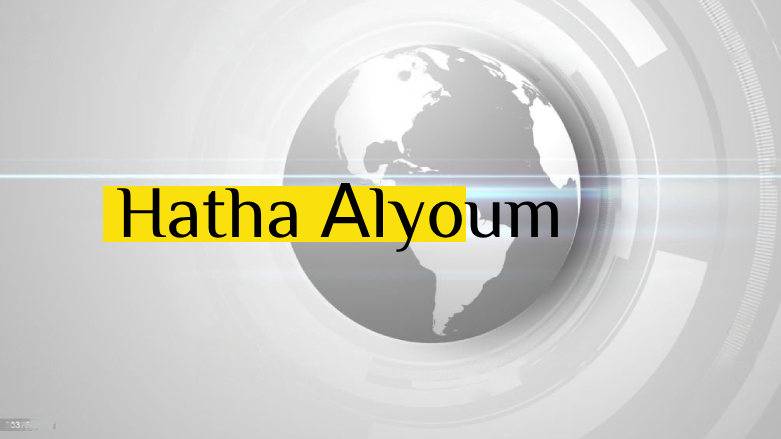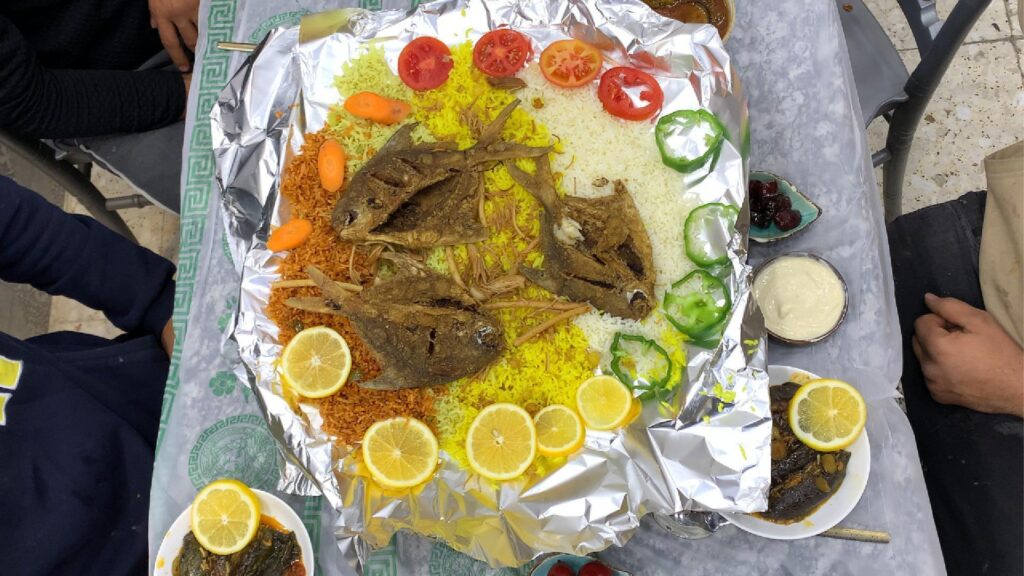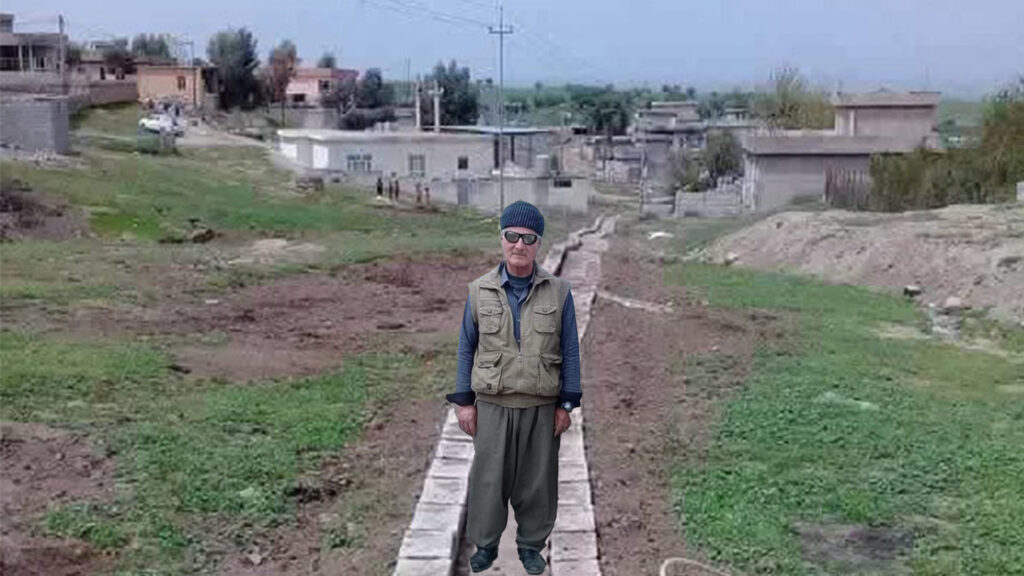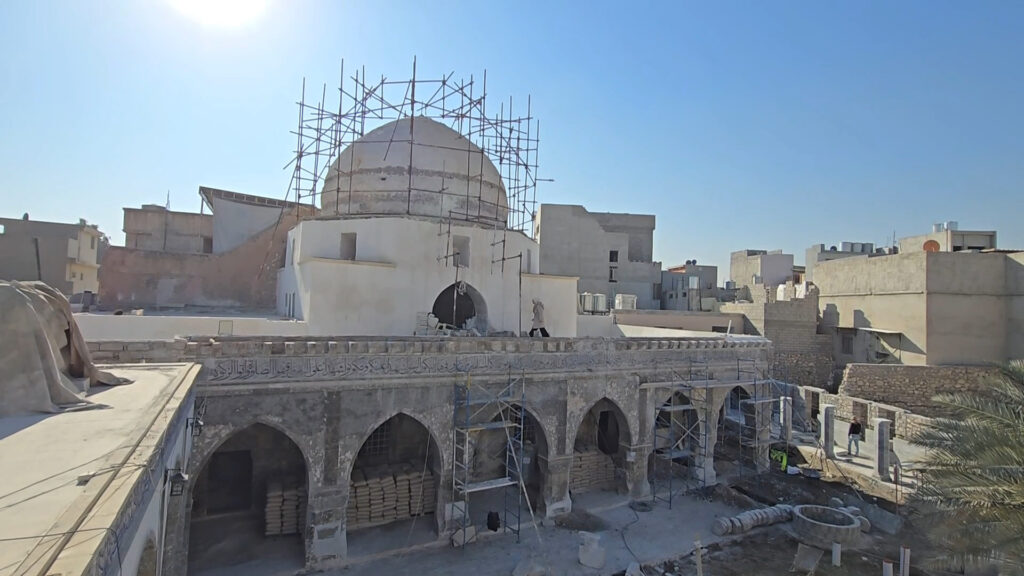Yazidis In Limbo As Iraqi Forces & Armed Militants Fight in Northern Iraq

DUHOK, Iraqi Kurdistan—On a warm afternoon, 30-year-old Vian Ramo walked along an unpaved road inside an informal housing settlement in Sharya, a town in the Duhok province. Wearing a denim shirt, black T-shirt and pants, alongwith a little smile on her face, her wide-open hazel eyes had her looking alert and slightly disoriented.
She has been displaced with her husband and two children, ages 6 and 9, ever since 2014. That is when the Islamic State of Iraq and Syria (ISIS) seized Sinjar, a town inside a district of the same name that is home to the ethno-religious Yazidi minority group in northern Iraq. That forced 300,000 Yazidis to flee their homes en masse, facing genocide from the extremist group.
“That night, our neighbors suddenly woke us up saying ‘They [ISIS] are coming to attack us,’” the 30-year-old recounted to Toward Freedom about the day when the group invaded their town after capturing Mosul just two months prior. “I saw many dead bodies then. ISIS forces were in front of us. We left everything behind, jumped in our car and escaped.”
After driving toward the Syrian border in an attempt to take refuge, the four family members ran into unidentified militants who opened fire, pushing them back. Then their car got a flat tire, prompting them to walk to the mountains, north of Sinjar. They stayed for five days without food, water and adequate clothing.
From there, they made another escape through a safe corridor opened by fighters of the People’s Protection Units (YPG), the Syrian Kurdish forces and the Kurdistan Workers’ Party (PKK) fighters. One neighbor gave them a ride in his sport-utility vehicle into Syria to then re-enter Iraq and seek safety in the Kurdistan Region of Iraq (KRI) in the north.
“It’s very difficult for us seeing our people driven out once more,” Ramo sighed, referring to the recent wave of displacement caused by fighting in Sinjar. “It takes us back to those dark, unsettling days.”
In August 2014, the Islamic State swept through northern Iraq, launching a genocidal campaign involving murder, abduction, rape and enslavement, resulting in some 300,000 Yazidis being displaced from their heartland of Sinjar, which spans 2,928 square kilometers (1,131 square miles) in northern Iraq. ISIS considers Yazidis to be apostates—or those who had renounced or abandoned a religion—for following a faith that is similar to Zoroastrianism, a monotheistic religion that originated in Iran.
Yazidis are an ethno-religious community indigenous to Kurdistan, which includes parts of Iraq, Syria, Turkey and Iran. They have settled predominantly in northern Iraq. Many Yazidis claim they are a religious sub-group of the Kurds, while others reject the Kurdish identity, identifying themselves as a separate ethno-religious group. Yazidis have endured a long history of persecution at the hands of Arabs, Persians, Turks and Sunni Kurds for their often-misinterpreted beliefs. Though their original language is related to the Iranic language of Kurdish, many also speak Arabic, given their proximity to Arab neighborhoods and Ba’athist Arabization campaigns. They share a strong connection to their lands in northern Iraq, especially around their main temple in Lalish, the holiest site of the Yazidi faith.
‘When You Have Nothing, You Always Think About Tomorrow’
After staying early on in different unfinished buildings in the Duhok area, Ramo now lives with her family in a one-room concrete house they rent in an informal settlement in Sharya. The structure originally contained no kitchen and the bathroom is outside. The family created a kitchen inside the house using a lightweight panel as a ceiling. Her husband doesn’t have a degree and works as a day laborer. She had never graduated because they fled Sinjar when she was still in high school. That keeps her from finding work, too.
Being on a low, unstable income—and having both kids in school—makes it hard for the couple to make ends meet.
Sometimes, they don’t have enough food to feed their children. Occasionally, they had borrowed money from their neighbors to buy proper clothes for the two and paid them back when they were able.
“We’re barely coping. All Yazidis here suffer from poverty,” the longtime displaced woman complained. “When you have nothing, you always think about tomorrow and how you’re going to pay the rent and bills.” She wishes one day she can resume and finish her studies, then do a degree in nursing or pharmacy and find a secure job.
On the other hand, going back to Sinjar is not an option for Ramo right now.
“ISIS bombed our home—we don’t have a place to stay there,” she said. “If there was reconstruction and security, it would be okay for us to return.”
Then she added without hesitation, her voice sinking low, “There’s no sign that Sinjar will be safe any time soon.”
Thousands Displaced Amid Years of Fighting
Heavy clashes occurred May 2 and May 3 in Sinjar between the Iraqi army and the Sinjar Resistance Units (YBS) forces as well as Ezidxane Security Forces in the Sinune sub-district of Sinjar over their ties with PKK. That escalation led to a displacement of more than 10,000 people from the district, this being the second or third time they have been pushed out of their homes. In total, 300,000 Yazidi IDPs have fled to Iraqi Kurdistan since 2014.
Since May 2, dozens of people in the Sinjar district have held demonstrations, demanding both an end to the fighting and for armed groups to evacuate towns, as the unstable security situation in the area prevents families from returning to their homeland.
Two-thirds of Sinjar’s population have been stuck in limbo, many of them reluctant to return from camps in KRI, even after ISIS was defeated. Meanwhile, others have gone back in recent years, despite the security risks and challenges they are confronted with at home, such as damaged infrastructure, minimal services, limited livelihood opportunities and little government support.
Amid the chaos, a group of Yazidi women can be found learning skills at the Enterprise & Training Center (ETC) run by the Free Yezidi Foundation (FYF)—a non-profit, humanitarian civil-society organization—in Khanke town, near Duhok. The center mainly teaches crafts, artisan textile production, carpet weaving, and baking skills, along with basic business management and business mathematics. About 100 Yezidi women are trained each year in baking, for instance.
Sitting among the women was Amira Salah, who had just taken part in a knitting session. The 34-year-old came forward quietly, dressed in black pants along with a blue blouse dotted with pink polka dots. She limped with a limb disabled since birth to a different room at the other end of the building.
She and her family are among the thousands of Yazidis who were pushed out of their place of origin in 2014. Their apartment building in Sinjar was destroyed during the ISIS invasion.
“Our home is in ruins until now,” the young woman uttered, lowering her head and skipping instead to recount about her arrival in Khanke, making it obvious to this reporter she was not keen to talk about the ordeal she and her loved ones experienced when the Islamic State attacked the area of Sinjar.
After taking shelter in different places around Khanke, Salah has lived with her mother and two sisters in Khanke camp for internally displaced persons (IDPs) for the last three years.
Like in all camps, living conditions in Khanke are dire. Water supply is inadequate, running every two or three days. Power outages are common, with IDPs staying without electricity for one, two or three days in a row. Dwelling in a 4-meter by 2-meter (13-foot by 6.5-foot) nylon tent, the family is exposed to extreme temperatures in summer as well as in winter.
Only primary healthcare is provided, so the 34-year-old—who has difficulty walking—must find medical assistance outside the camp, which can be unaffordable. “I have to travel to Duhok to get better service and for regular checkups,” she said. “The same goes for one of my sisters who has a speech impairment and my mum who suffers stomach-related issues.”
Managing such a precarious situation for an extended period has been proving for the family of four. “We, Yazidi people, have been helping each other because nobody has helped us during all this time,” Salah emphasized.
Illiterate and unable to access basic education at her age, she recently completed a knitting course at FYF’s training center. From time to time, she now takes home a small amount from selling knitted toys and animals, just to contribute to her family. She is looking for any kind of work she can do to help out more. Her youngest sister, 25, working as a nurse, is the only one at home who has a regular job, earning around $400 a month.
At the moment, Salah ruled out the possibility of returning to her hometown. “I don’t expect Sinjar to be rebuilt, so that people can go back,” she said. Then, without hesitation, she wished aloud, “If only security was restored… at least!”
Then Salah concluded in a gloomy tone, “Sinjar is in such a state that makes you want to stay here.”
Post-ISIS, Return and Reconstruction In Limbo
Eight years after the brutal rule of ISIS, much of Sinjar remains in rubble. It lacks schools and hospitals, infrastructure, and other basic services. Thus, jobs are nowhere to be found.
The town lies in disputed mountainous lands in northwestern Iraq between the jurisdictions of the central Iraqi government and the Kurdish Regional Government (KRG). Sinjar’s security situation remains complex due to the presence of different competing armed groups, including the Iraqi military, the Kurdistan Democratic Party (KDP), Patriotic Union of Kurdistan (PUK), the local YBS force and Popular Mobilization Forces (PMF).
Although the federal government and the KRG signed an agreement in October 2020 to preserve security in Sinjar—with Iraqi forces working in coordination with KRG forces—little progress has been made toward implementing it. Moreover, members of the Yazidi community criticized the deal for not including their input.
On top of it, Turkey frequently conducts ground and air offensives in Sinjar against alleged locations of the PKK, which Ankara has labeled a terrorist organization for claiming it has a right to inhabit the southeast portion of Turkey. A U.S. State Department report published early this month stated the presence of PKK-affiliated armed forces—as well as Turkish airstrikes—prevents Yazidi IDPs from going back to the affected areas.
An International Crisis Group report released at the end of May showed the Sinjar agreement has failed to stabilize the area, and that leaving the situation as it is will attract more violence and displacement.
In a meeting with representatives from Sinjar town, a week after May’s confrontations, Iraqi Prime Minister Mustafa Al-Kadhimi said the Sinjar agreement should be implemented. The premier also called on relevant authorities to accelerate the completion of procedures for establishing the Sinjar Reconstruction Fund.
Despite Iraqi forces and the YBS group reaching a ceasefire in early May, Yazidis fear fighting could resume at any time unless a radical solution is found to bring security to the contested district.
A local official affiliated with the KRG declined to discuss the situation of Sinjar after several attempts, and a spokesperson for the Joint Operations Command from the Iraqi Ministry of Defense could not be reached for comment.
‘Camp Life Is Miserable’
Hewan Omer, FYF Country Director in Iraq, pointed out lack of safety is the most crucial deterrent against the return of Sinjaris. “There is no governmental entity that locals can rely on. Only militias fighting against each other. People don’t feel safe in Sinjar,” she told Toward Freedom, adding that, because of the ongoing insecurity, many in the community cannot find some reassurance that a genocide will not be repeated.
Hinting at non-functional public water and electrical networks, the country director expressed disappointment about the government inaction in the area, which has hindered Yazidis from rebuilding their lives after years of tragedy, destruction and insecurity.
“We haven’t seen any tangible steps taken to improve security or restore basic services, to incentivize the return of displaced families,” she said.
Khalida Nawaf, ETC’s manager at FYF in Khanke, implied widespread concern exists among Yazidis that the underlying cycle of violence may produce some terrible events again. “None of us can forget that black day when ISIS assaulted Sinjar,” she told Toward Freedom. “Nothing’s been done on the ground, Sinjar is unsafe. We fear another August 3, 2014, could happen.”
Nawaf estimated about 80 percent of Sinjaris have mental health issues as a result of the violence they experienced.
A prominent Yezidi civil-society organization, FYF provides humanitarian support to Yazidi civilians, with a special focus on trauma recovery and psychological services, economic empowerment, community reintegration, and education.
Nawaf noted that both the KRG and the government in Baghdad should coordinate efforts to provide security in the area, proceed with the reconstruction of civilian houses and infrastructure, increase educational establishments, and ensure public services operate normally.
Hanging out in front of a garage in Khanke was Zaid Hamu, 33. He donned a white T-shirt and black trousers, along with a baseball cap.
With his spouse and four kids—between the ages of 18 months and 10 years—the Yazidi man continues to live in displacement after they ran from the ISIS aggression in 2014. “It’s been so long. Eight years!” he exclaimed, talking to Toward Freedom. Then the conversation turned to his fellow Sinjaris, who crossed into Kurdistan last month in the wake of fresh clashes. “Things are going from bad to worse.”
At the time he and his family fled their home in Sinjar, most villagers left in the early morning. He recounted they headed on foot to the southern side of the mountains. They spent nine days there until a corridor was cleared for the evacuation of Yazidi civilians into Syria, enabling them to reach the neighboring Kurdish region and settle in the Khanke IDP camp.
“Our house is still there, but looks like an empty wreck,” the young man said in a bitter tone. “ISIS fighters ransacked it and took everything.”
Like many Yazidis, Hamu is displaced in his own country. A former interpreter for an NGO, he is currently jobless while his wife takes care of the children, meaning no income whatsoever.
“Camp life is miserable,” he uttered. IDPs deal with unbearably hot summers and freezing winters inside tented dwellings. A consistent supply of water and electricity can’t be counted on. The father of four also criticized the quality of education, saying the school where his kids are enrolled is ill-equipped, with overcrowded classrooms. Rotational learning restricts pupils to only attend three days a week.
Then again, restarting his life in Sinjar is unthinkable. “It’s not safe there. There aren’t even the most basic services,” the 33-year-old decried. He held the Iraqi government responsible for doing nothing to secure the area or incentivize the return of displaced Yazidi to their native land.
Looking to seek asylum, he hopes to see himself in any other country. “Nothing holds me here. I’ve had enough,” Hamu said, his face appearing worn out. “I want a better future for my family.”
Harsh Living Conditions in Camps
An estimated 300,000 Yazidis remain displaced in Iraq’s Kurdistan region. According to the United Nations High Commissioner on Refugees (UNHCR) in Iraq, fewer than 136,000 individuals are scattered across 15 IDP camps in the governorates (provinces) of Duhok and Nineveh, while another 195,000 live independently in the area.
Inside camps, the majority still live in tents, which makes them vulnerable to harsh weather conditions and fire hazards. They often have little to no access to running water, electricity, heating and sanitation.
Minimal health services are provided, while non-basic medical treatment only is available a few miles away in Duhok. However, many are unable to cover transportation costs to get there.
Schools in IDP camps typically suffer from overcrowding, a lack of basic facilities and qualified teaching staff, which means many schools have to run multiple shifts. Understaffing is supplemented by untrained community members, working as volunteers or for a small stipend, further compromising educational standards.
IDPs rely on the minimum food assistance provided by the KRG and humanitarian organizations. The World Food Program (WFP) distributes food aid in the form of monthly food baskets or cash transfers ranging between 10,000-20,000 Iraqi dinar per month (USD $7 to $14) for each person. However, because of funding gaps, the impact of climate change on global food production, and inflation’s impact on food prices, WFP has stopped financial assistance to all displaced people starting this month. That is, except for in the case of families that can demonstrate their poverty.
For the majority of IDPs who reside outside camps in informal settlements and in urban areas, humanitarian assistance is even less available. They face difficulties in accessing employment that would enable them to meet their basic costs of living, and many can only find casual work, putting large numbers at risk of eviction and/or forcing them to relocate to IDP camps, according to the UNHCR.
FYF’s Omer explained that low education levels, missing documentation, and lack of work experience in sectors other than construction and agriculture limit their prospects. IDPs generally operate fruit and vegetable shops, work on construction sites, or do seasonal farm work for a wage of 7,000 Iraqi dinar (USD $4.8) per day.
Obstacles to Returning Home
Throughout the ISIS occupation, 80 percent of public infrastructure and 70 percent of civilian homes in Sinjar were destroyed, according to a report by the UNHCR and REACH, a nonprofit organization that analyzes data on crises, disasters, and displacement.
Last year, the International Organization for Migration (IOM) provided cash assistance to 1,400 families to facilitate the return process.
Beyond that, international organizations have done little to help communities return, whether by repairing basic infrastructure, supporting the local government to ensure provision of essential services, or assisting families in finding sustainable solutions to live in better conditions.
A recent Norwegian Refugee Council (NRC) report found ongoing challenges in accessing housing, land and property rights. Damaged infrastructure, lack of habitable housing, insecurity, and property disputes inhibit displaced families’ return and increase social tensions in Sinjar.
According to the study, 64 percent of IDPs from Sinjar claimed their homes were heavily damaged. For 70 percent, lack of housing and rent increases are the primary source of social conflict among those who have returned. The study relayed 92 percent of returnees reported continued access to their property. In contrast, 99 percent of those who applied for government compensation have not received any funding for damaged property.
NRC urged Baghdad and the KRG to prioritize the rehabilitation of infrastructure and the restoration of services to allow for safe housing, land, and property, alongside public infrastructure. It also called on international development donors to invest in strengthening access to housing, land and property rights to support families in finding solutions for a life back in Sinjar.
“As long as no concrete action is taken in their place of origin, and the situation gets better, most displaced Yazidis are bound to stay here,” FYF’s Omer said, exhaling deeply.
Alessandra Bajec is a freelance journalist specializing in West Asia and North Africa. Between 2010 and 2011, she lived in Palestine. Then she was based in Cairo from 2013 to 2017. Since 2018, Bajec has lived in Tunis.











